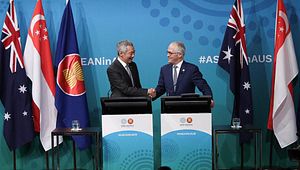Over the weekend, Australia hosted its first-ever summit with ASEAN on Australian soil. Though much of the headlines were focused on the wording of statements and other individual developments, the broader significance of the summit lies in what it says about Southeast Asia and ASEAN’s role in the region today, the subregion and the regional bloc’s importance within Canberra’s broader foreign policy, and the opportunities and challenges that lie ahead for both sides moving forward.
Seen from a broader historical perspective, the Special Summit was yet another manifestation of Australia’s enduring ties with Southeast Asia and ASEAN. Australia has long been recognized as a major actor in the subregion, with manifestations of that presence including its membership in the Five Power Defense Arrangements (FPDA) and its status as ASEAN’s first-ever dialogue partner back in 1974. This level of commitment is not surprising given Canberra’s geographic proximity as well as its economic and security interests, even if we have seen changes in aspects of that involvement with different governments in Australia and variance in the receptivity toward that involvement among Southeast Asian states.
It is therefore little surprise that leaders have framed the Summit as part of this broader history. During Australian Prime Minister Malcolm Turnbull’s remarks at the Shangri-La Dialogue last year in Singapore, where he previewed the ASEAN-Australia Special Summit, he recalled Foreign Minister Paul Hasluck’s comment in response to the British withdrawal of its forces east of Suez, first announced in 1968 – a period of heightened uncertainty for ASEAN – by saying, “Others can go but we can’t go home because this is our home.” Singapore Prime Minister Lee Hsien Loong, who is chairing ASEAN this year, opened his remarks at the ASEAN-Australia Special Summit over the weekend by noting that the interaction was the product of a “longstanding” partnership.
But, in truth, the Summit was also an acknowledgement of how far Southeast Asia as a region and ASEAN as a regional grouping have come since then in spite of remaining challenges. When Australia became ASEAN’s first dialogue partner back in 1974, the regional bloc was a fledgling group of just five Southeast Asian states in the midst of the Cold War. Today, ASEAN, with ten member states and Timor -Leste being gradually integrated, is collectively the world’s sixth largest economy and is a convener and shaper of the evolving regional security architecture in its own right. Whatever the ifs and buts, that is a level of progress that far surpasses what skeptics had imagined during the regional bloc’s initial conception.
As a result, it is no surprise that we have seen more major powers place a greater emphasis on Southeast Asia and ASEAN over the past few years. Indeed, for all the hype about this Australia-ASEAN Special Summit, it is worth noting that Australia is just the latest of several major powers to hold special engagements or unveil specific strategies for ASEAN as a bloc (See: “What’s Behind the First ASEAN-Australia Special Summit?“). That long list notably includes not only regional actors such as Japan, India, South Korea, and Taiwan, but also skeptics of multilateralism such as the United States.
The Summit was also testament to the importance Australia attaches to Southeast Asia as well as ASEAN in its wider foreign policy today. To be sure, there are other indicators of Australia’s recognition of the subregion’s importance for its interests, like the 2017 Foreign Policy White Paper. But the Special Summit was additionally significant because it reinforces Canberra’s commitment to multilateralism within its broader approach to Southeast Asia amid lingering uncertainty in some circles about the value of engaging ASEAN. In following other recent steps such as the new ASEAN-Australia strategic partnership in 2014 and a biennial leaders’ summit commencing in 2016 with this Special Summit so quickly, the Turnbull government has sent a powerful message about where it stands on this question right now.
On a related note, the Summit was also an opportunity to actually tangibly demonstrate the value of greater Australian engagement of Southeast Asia and ASEAN. To be sure, much of that actual collaboration has already been taking place at lower levels and through other mechanisms such as the plan of action for the strategic partnership out to 2019. But the Sydney Declaration noted some of the key issues that both sides have been working on across the security, economic, and people-to-people realms, including areas where Australia has been playing an important role as an ASEAN dialogue partner such as humanitarian assistance and disaster relief and cybersecurity. The two more specific meetings on counterterrorism and business also provided additional opportunities for advancing the agenda on these fronts as well.
Of course, the Special Summit should not detract from the significant challenges that remain ahead for both sides. To take just one example, Philippine President Rodrigo Duterte’s absence from the Special Summit, and Myanmar’s de facto leader Aung San Suu Kyi’s presence there amid continued scrutiny on the Rohingya crisis, reinforced the rights concerns that come with Canberra’s engagement of Southeast Asia. More broadly, despite the holding of this summit, there are lingering concerns both about Southeast Asia on various fronts, from setbacks to democracy to coercion by China, as well as the role of the subregion and the regional bloc in Australian foreign policy relative to other major powers.
But the work that lies ahead of the Summit should not detract from what has just been accomplished over the weekend. The ASEAN-Australia Special Summit is a tangible and powerful demonstration of how far Southeast Asia and ASEAN has come over the decades and how far the Turnbull government is willing to go to signal the subregion and regional bloc’s importance to its interests. And irrespective of one’s views about ASEAN or Australia’s engagement with it, it deserves to be acknowledged as such.

































